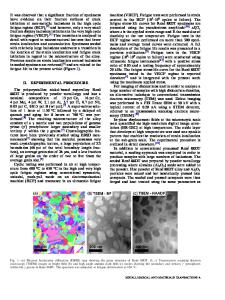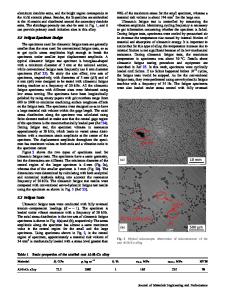A theory of fatigue crack initiation at inclusions
- PDF / 724,663 Bytes
- 7 Pages / 594 x 774 pts Page_size
- 43 Downloads / 415 Views
I.
INTRODUCTION
THE fatigue
strength of high strength alloys is often reduced by the presence of inclusions. Modes of fatigue crack initiation at inclusions depend on the matrix material, types of inclusions, and properties of the interface between inclusions and the matrix. A control of these metallurgical factors is important for alloy designers. Several microscopic observations have been conducted to clarify several micromechanisms of fatigue crack initiation. In high strength steels, the fatigue limit is much lower than the yield stress, and the fatigue strength is reduced by the presence of inclusions. 1-5 Lankford and KusenbergeP summarized a series of stages occurring in fatigue crack initiation at inclusions. The initial stage is the interface debonding of the inclusion from the matrix. Lankford 5 found that this debonding takes place by the first tensile loading even at a stress level close to the fatigue limit. Cracks initiate at the interface with the matrix after this debonding. The major part of the crack initiation life is consumed after the debonding. The initiation of a fatigue crack in the matrix is expected to be caused through an ordinary slip mechanism. 3'4 The influence of the inclusion size on the fatigue limit of high strength steels was analyzed by Morrow. 6 He regarded the inclusions as notches or voids, and utilized the concept of the notch-fatigue strength reduction factor to evaluate the strength reduction due to inclusions. His analytical results agree fairly well with the experimental data reported by Cummings and others. 1,2 His analysis is basically macroscopic, and the microstructural effect on the crack initiation is included in terms of the correction factor by Peterson.7 In an aluminum alloy, 2024-T4, on the other hand, Grosskreutz and Shaw 8 observed that the interracial debonding takes place after a sufficient amount of cyclic slip deformation in the matrix. Morris and his coworkers 9-~2 have made extensive observations on crack initiation at inclusions in AI 2219-T851 alloys under maximum cyclic stresses K. TANAKA is with the Department of Mechanical Engineering and Mechanics, Lehigh University, Bethlehem, PA 18015. T. MURA is with the Department of Civil Engineering, Northwestern University, Evanston, IL 60201. Manuscript submitted March 31, 1981. METALLURGICAL TRANSACTIONS A
lower than the matrix yielding stress. They found that the inclusions were cracked along the laminated structure or debonded at the inclusion-matrix interface. The inclusion cracking of this type was theoretically analyzed by Chang and others 13with the use of a dislocation pile-up model at an inclusion. Their analysis was based upon an assumption of dislocation accumulation by cyclic stressing. Chang's analysis was later modified through rather ambiguous approximations to give an agreement with the experimental data on a statistical distribution of inclusion crackings. 11 Another type of fatigue crack initiation at inclusions in 2024-T4 A1 alloy was reported by Kung and Fine. 14 They found that a fa
Data Loading...











